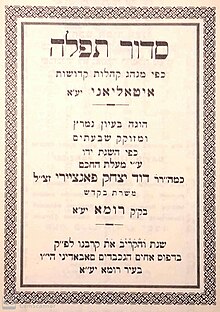Italian Nusach
This article, Italian Nusach, has recently been created via the Articles for creation process. Please check to see if the reviewer has accidentally left this template after accepting the draft and take appropriate action as necessary.
Reviewer tools: Inform author |
This article, Italian Nusach, has recently been created via the Articles for creation process. Please check to see if the reviewer has accidentally left this template after accepting the draft and take appropriate action as necessary.
Reviewer tools: Inform author |
 Comment: On the right track. Inclined to accept once inline citations are used for any information from a reliable outside source. Bkissin (talk) 20:37, 15 July 2020 (UTC)
Comment: On the right track. Inclined to accept once inline citations are used for any information from a reliable outside source. Bkissin (talk) 20:37, 15 July 2020 (UTC)
| An editor has marked this as a promising draft and requests that, should it go unedited for six months, G13 deletion be postponed, either by making a dummy/minor edit to the page, or by improving and submitting it for review. Last edited by DGG (talk | contribs) 3 years ago. (Update) |

Italian Nusach, also known as Minhag Italiani, Minhag B'nei Romì, Minhag Lo'ez or Minhag HaLo'azim, is the ancient prayer rite of the Jews on the Italian peninsula who are not of Ashkenazi or Sephardic origin.[clarification needed]
History
The Jewish presence on the Italian peninsula can be traced back to the 2nd century BCE and the Roman Jewish community was well-established already before the destruction of the Second Temple. Their prayer ritual developed into an independent nusach which cannot be grouped together with Ashkenazi or Sephardic rituals. No direct sources of the prayer rite of the Roman period have survived to the modern era.
The Italian nusach has been considered an offspring of the ancient Palestinian minhag and it has similarities with the nusach of the Romaniote Jews of Greece and the Balkans. However, the documents discovered in Cairo Geniza reveal that the influence of Minhag Eretz Israel on Benè Romì is less extensive that believed.[1]
The first significant development of Italian Judaism starts in the era of the latter Geonim. In his book Sefer ha-Qabbalah Raavad mentions the arrival of two Babylonian emissaries in Bari in the end of the 10th century, on a quest to gather funds for Torah schools in Babylon. With the emissaries the culture of the Geonim landed in Europe and started to spread across the communities. This explains also the strong influence of the Babylonian Talmud on the Italian nusach.
The Italian peninsula was touched by intense Jewish migrations. Jews expelled from the Iberian peninsula had a major impact on the coastal areas whereas the influence of the Ashkenazi world strengthened in the northern regions. Despite these two major dominators the Italian nusach practiced by single and insular communities managed to survive as an independent rite, until the present day.
The first Machzor
The machzor of Benè Romì was the first-ever printed machzor. Its first edition started in September 1485 in the Lombardian town of Soncino. It was completed towards the end of the same year in Casalmaggiore by the famous printers Benè Soncino.
Distribution
The nusach is currently used by Jewish communities Ancona, Bologna, Mantua, Milan, Modena, Padua, Rome and Turin. Outside of Italy the only communities using this nusach are in Israel; in Ra'anana and at the Conegliano Synagogue in Jerusalem.
Distinctive characteristics
Although the Italian nusach is mostly based on the Babylonian order, it contains more ancient customs originating from Eretz Israel than the other nus'chaot.
- The first berachah of Shabbat eve Maariv begins "...Ashèr killà ma'asàv ba'yom ha'shvi'i".
- The third berachah of Shabbat eve Maariv is "Emet ba'shvi'ì kiyamta"
- The middle benediction of the Amidah prayer of Shabbat eve says "U'meahavatach A. Eloheynu she'ahavta et Israel amach" instead of "Ata kidashta".
- The text of the 3rd berachah of the Amidah prayer is "Le'dor va'dor namelich la'E-l" even in the silent prayer.
- On weekdays the Torah scroll returns to the Aron ha'Qodesh between Ashrei' and U'va le'Tziyon.
- Aleinu leshabeach is not said between Mincha and Maariv prayers.
- Like in the Yemenite Baladi-rite prayer, the Kaddish prayer is recited with the double le'eyla-le'eyla form all year round.
- On Shabbat an additional Nachameinu is recited after the 3rd blessing of Birkat ha'mazon.
- The Kol nidrei prayer on Yom Kippur eve is recited in Hebrew instead of Aramaic, "Kol nedarim".
- The Kedushah text includes the form "Keter" in all prayers, even on weekdays.
- The Italian nuachs has an individual set of haftaroth which occasionally coincide with the Ashkenazi or the Sephardic texts.
References
- ^ D. Goldschmidt, Minhag Benè Roma

